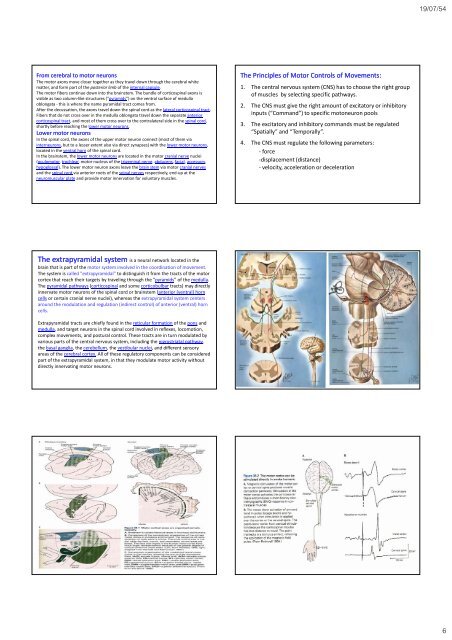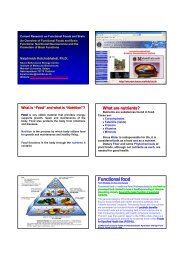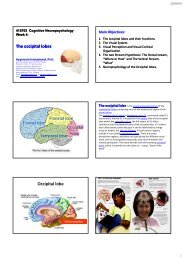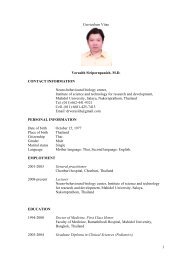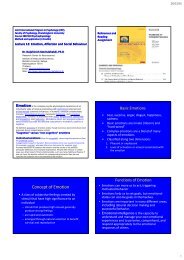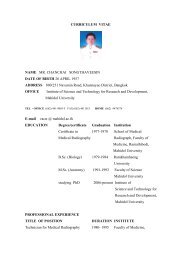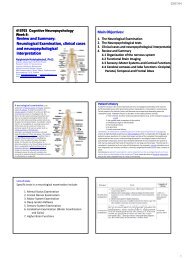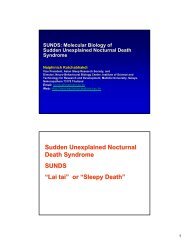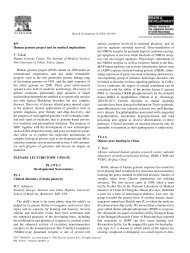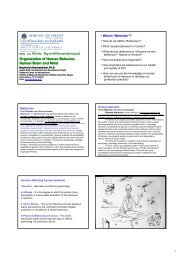The Frontal lobes - Mahidol University
The Frontal lobes - Mahidol University
The Frontal lobes - Mahidol University
Create successful ePaper yourself
Turn your PDF publications into a flip-book with our unique Google optimized e-Paper software.
19/07/54<br />
From cerebral to motor neurons<br />
<strong>The</strong> motor axons move closer together as they travel down through the cerebral white<br />
matter, and form part of the posterior limb of the internal capsule.<br />
<strong>The</strong> motor fibers continue down into the brainstem. <strong>The</strong> bundle of corticospinal axons is<br />
visible as two column‐like structures ("pyramids") on the ventral surface of medulla<br />
oblongata ‐ this is where the name pyramidal tract comes from.<br />
After the decussation, the axons travel down the spinal cord as the lateral corticospinal tract.<br />
Fibers that do not cross over in the medulla oblongata travel down the separate anterior<br />
corticospinal tract, and most of them cross over to the contralateral side in the spinal cord,<br />
shortly before reaching the lower motor neurons.<br />
Lower motor neurons<br />
In the spinal cord, the axons of the upper motor neuron connect (most of them via<br />
interneurons, but to a lesser extent also via direct synapses) with the lower motor neurons,<br />
located in the ventral horn of the spinal cord.<br />
In the brainstem, the lower motor neurons are located in the motor cranial nerve nuclei<br />
(oculomotor, trochlear, motor nucleus of the trigeminal nerve, abducens, facial, accessory,<br />
hypoglossal). <strong>The</strong> lower motor neuron axons leave the brain stem via motor cranial nerves<br />
and the spinal cord via anterior roots of the spinal nerves respectively, end‐up at the<br />
neuromuscular plate and provide motor innervation for voluntary muscles.<br />
<strong>The</strong> Principles of Motor Controls of Movements:<br />
1. <strong>The</strong> central nervous system (CNS) has to choose the right group<br />
of muscles by selecting specific pathways.<br />
2. <strong>The</strong> CNS must give the right amount of excitatory or inhibitory<br />
inputs (“Command”) to specific motoneuron pools<br />
3. <strong>The</strong> excitatory and inhibitory commands must be regulated<br />
“Spatially” and “Temporally”.<br />
4. <strong>The</strong> CNS must regulate the following parameters:<br />
‐ force<br />
‐displacement (distance)<br />
‐ velocity, acceleration or deceleration<br />
<strong>The</strong> extrapyramidal system is a neural network located in the<br />
brain that is part of the motor system involved in the coordination of movement.<br />
<strong>The</strong> system is called "extrapyramidal" to distinguish it from the tracts of the motor<br />
cortex that reach their targets by traveling through the "pyramids" of the medulla.<br />
<strong>The</strong> pyramidal pathways (corticospinal and some corticobulbar tracts) may directly<br />
innervate motor neurons of the spinal cord or brainstem (anterior (ventral) horn<br />
cells or certain cranial nerve nuclei), whereas the extrapyramidal system centers<br />
around the modulation and regulation (indirect control) of anterior (ventral) horn<br />
cells.<br />
Extrapyramidal tracts are chiefly found in the reticular formation of the pons and<br />
medulla, and target neurons in the spinal cord involved in reflexes, locomotion,<br />
complex movements, and postural control. <strong>The</strong>se tracts are in turn modulated by<br />
various parts of the central nervous system, including the nigrostriatal pathway,<br />
the basal ganglia, the cerebellum, the vestibular nuclei, and different sensory<br />
areas of the cerebral cortex. All of these regulatory components can be considered<br />
part of the extrapyramidal system, in that they modulate motor activity without<br />
directly innervating motor neurons.<br />
6


